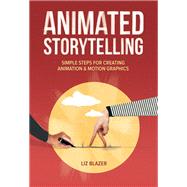Animation is a limitless medium for telling stories. Artists can create worlds, defy gravity, flip from factual to fantasy, and transport audiences to places they never imagined. The challenge is having the discipline to reel it in and be intentional about your storytelling choices. This book shows you how.
In Animated Storytelling, you’ll learn how to create memorable stories using animation and motion graphics by following 10 simple guidelines that take you through the stages of concept development, pre-production, storyboarding, and design. Award-winning animator Liz Blazer uses clear examples and easy-to-follow exercises to provide you with the instruction, encouragement, and tools you need to get your designs moving.
Whether your goal is to create exciting shorts for film festivals, effective messaging for broadcast or online, or simply to gain a deeper understanding of the medium, Animated Storytelling simplifies the process of creating clear and engaging stories for animation and motion graphics so you can get started easily.
In Animated Storytelling, you’ll learn how to:
- Write a creative brief for your project
- Find and communicate your story’s big idea
- Create a tight story using linear and nonlinear story structures
- Use color to clarify and enrich your story
- Define the rules for your animated world, and commit to them
- Ease into the challenging task of animation
- Make the work you want to be hired to do
- Share your work with the world!








